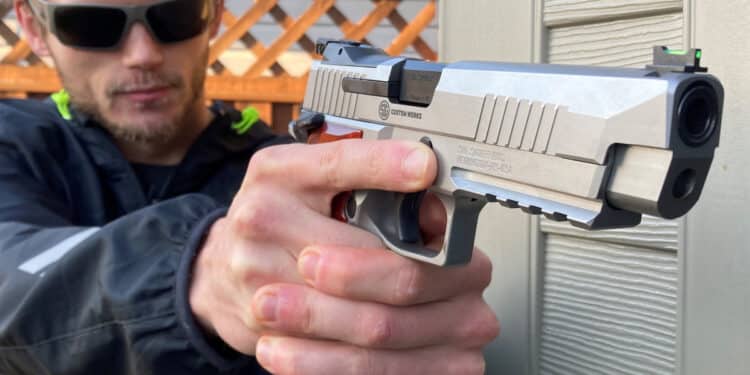By Todd Burgreen –
SIG Sauer HQ in Newington, NH has been a busy place the last several years. Multiple successes with major military and law enforcement solicitations have that effect. Across the board—long arms, handguns, SMGs, belt fed machine guns, suppressors, optics, and ammunition—SIG is at the top of the heap as a manufacturer and a developer.
The company’s civilian offerings have been just as impressive. Unlike other manufactures, who often forget about their civilian customers after getting a taste of military contracts, SIG’s dynamic leadership team keeps the hammer down by feeding the market with its current production pistols while offering new items based on feedback from its customers. Even with their preeminent position, SIG has no problem expanding their product line by offering weapons that many considered unobtainable at one point. We’re talking about releases of classics like the P210 Target and P210 Carry. Another recent entry into this category has pistol aficionados sitting up and taking notice—the P226 XFIVE is now made here in the U.S. in the SIG Custom Works shop. Previous P226 XFIVE’s were Teutonic offerings from the German-based SIG MasterShop. These were discontinued in 2012.

Before we get into P226 XFIVE details, let’s get a little background on the P226 pistol family. The SIG Sauer P226 was spawned from the P220. P220 design work started in the late 1960s when the Swiss wanted a less pricey sidearm in lieu of the P210, which had a complex (and expensive) manufacturing process. The P220 entered Swiss service in 1975.
Many of the innovative features introduced on the P220/P226 family still prevail today on more recent designs from SIG, as well as on other manufacturer’s weapons. A great example is how SIG modified Browning’s locked breech short recoil design. Instead of slots machined into the slide interacting with locking rings on top of the barrel, SIG utilized the forward edge of the chamber which locks into the slide’s ejection port. This removed complex machining operations from the production process. De-cocking lever, automatic firing pin safety, and a pinned breechblock in the steel slide are other examples of SIG-perfected concepts that are common today.
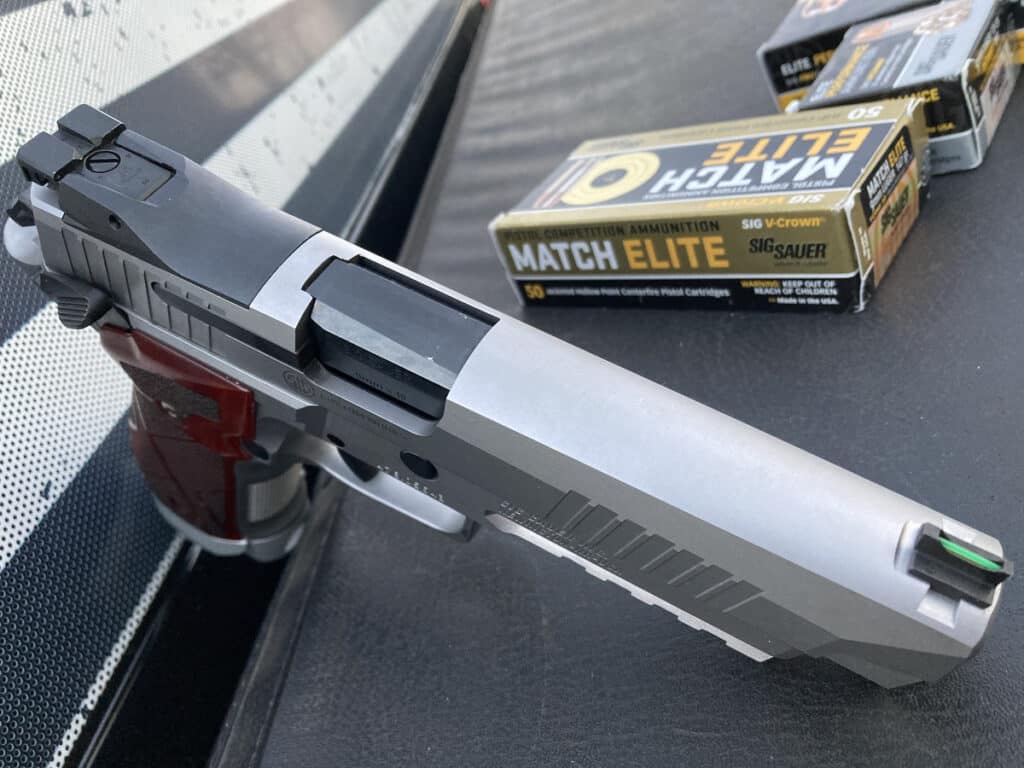
The P226 reflected SIG’s quest to generate an entry for the early 1980’s US XM9 joint service pistol trials conducted to find a replacement for the M1911A1. The P226 was modified from the P220 design to accept double column magazines. When the dust settled after years of testing and evaluation, only the Beretta 92F submission and SIG P226 satisfactorily completed the trials. As most readers already know, the P226 was not chosen to replace the venerable M1911A1. The Beretta 92F was given the nod for a variety of factors outside the scope of the article. The P226 test performance impressed a lot of observers, though. It gained the attention of various military units, many with elite status, and law enforcement agencies in the U.S. and around the world; with the U.S. Navy Seals preeminent on this list of interested parties. Early on, it was evident the P226’s reliability, accuracy, safety, and ammunition capacity set it apart from its handgun peers.
Features
The target audience, pun intended, for the P226 XFIVE is anyone wanting a tack-driving, long-slide P226 variant. The XFIVE features support this role—extended, railed dust cover, all-steel construction (instead of the typical P226 aluminum frame), 5-inch bull barrel, Dawson-style adjustable rear sight plate, fiber optic front sight, and, most significantly, a fully adjustable AX3 single-action only (SAO) trigger. Ambidextrous manual safeties are present on the XFIVE in lieu of the de-cocking lever usually found on the DA/SA P226. A low-profile alloy magwell is seamlessly fitted to the bottom of the grip. The three 20-round magazines with extended basepads that arrive with the XFIVE fit nicely into the magwell, aesthetically and functionally speaking.

The increased forward weight from the long dust cover and all steel construction (totaling 45.6 ounces of weight) minimizes recoil/muzzle flip. A pronounced beavertail further sets apart the P226 XFIVE from most other SIG Sauer P226 models. The custom Hogue Cocobolo grips and alloy magwell serve as notice that something special is afoot. With the XFIVE, SIG created a P226 that pushes the envelope. Along these lines, the Dawson rear sight plate can be removed to directly mount a SIG Romeo1Pro, Romeo2, or any other optic using the standard SIG “PRO” footprint.
The single action only trigger is definitely attractive, especially to those that have never been fond of DA/SA hammer-fired trigger characteristics—especially those looking at a target grade competition handgun. The P226 XFIVE offers the shooter the best of the P226 design with a more appealing single action-only trigger mechanism. The P226 XFIVE’s 5-inch cold hammer-forged barrel and SAO trigger combine with near perfect lock-up in the stainless steel slide/barrel interface to provide maximum accuracy; all the while maintaining excellent reliability.

The SAO trigger is a key component of the XFIVE equation. The XFIVE trigger characteristics aid in rapid target engagement with a trigger pull just under four pounds. The longer slide/barrel combo contributes more mass, aiding in increased muzzle control for double taps or longer strings of fire. SIG ergonomics, combined with the slide’s smooth tracking during recoil and manageable 9MM muzzle signature, allows for a very stable sight picture no matter how many or how rapid rounds are fired. The extended beavertail guides one’s hand to the optimum grip position during the draw stroke and aids in recoil management. It is not hard to fathom why some may consider the XFIVE applicable to personal defense/tactical work, not just target or match shooting.
The P226 XFIVE’s manual safeties are located within user’s natural thumb swipe distance. The slide lock lever sits further toward the rear of the frame compared to other handguns—the 1911 for example. This all but eliminates the chance of unintentionally engaging the slide lock during strings of fire—as can happen when shooters rest their thumb on the lever with other designs. Another positive attribute is that the P226 XFIVE’s safety can remain engaged while the shooter manipulates the slide.
Out of the Box
Our T&E was conducted at the Echo Valley Training Center, a private facility located near Winchester, VA. The SIG P226 XFIVE’s first test was verifying sight zero and then firing several magazines rapidly at various steel targets. This quickly shows if any reliability issues exist. The sights were zeroed out of the box for 25 yards. Further testing consisted of strings of fire against steel plate racks and popper targets at 7, 15, and 25 yards. Standard 15-round and extended 20-round P226 magazines without XFIVE basepads augmented the three 20-rounders that arrived with the XFIVE.
Sights
The SIG fiber optic front sight and target rear sight proved advantageous not only for monotonously stacking bullet holes on top of each other, but also for rapid shot placement when working a plate rack. The stock iron sights assist in maximizing accuracy with a crisp, clear sight picture with the fiber optic front gathering the right amount of light without being obscenely bright. The XFIVE sights tracked smoothly during recoil when firing multiple rounds. SIG has done an excellent job of providing a target-style sight that does not protrude grotesquely upward thanks to the way the Dawson-style plate is milled into the top of the XFIVE’s slide.
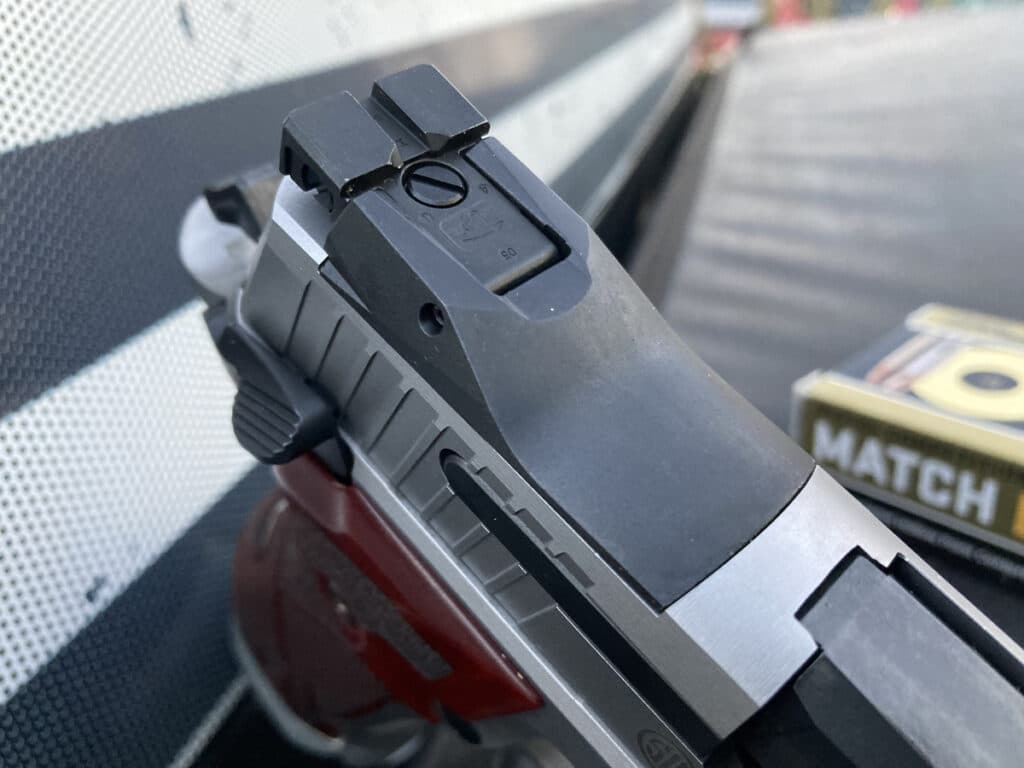
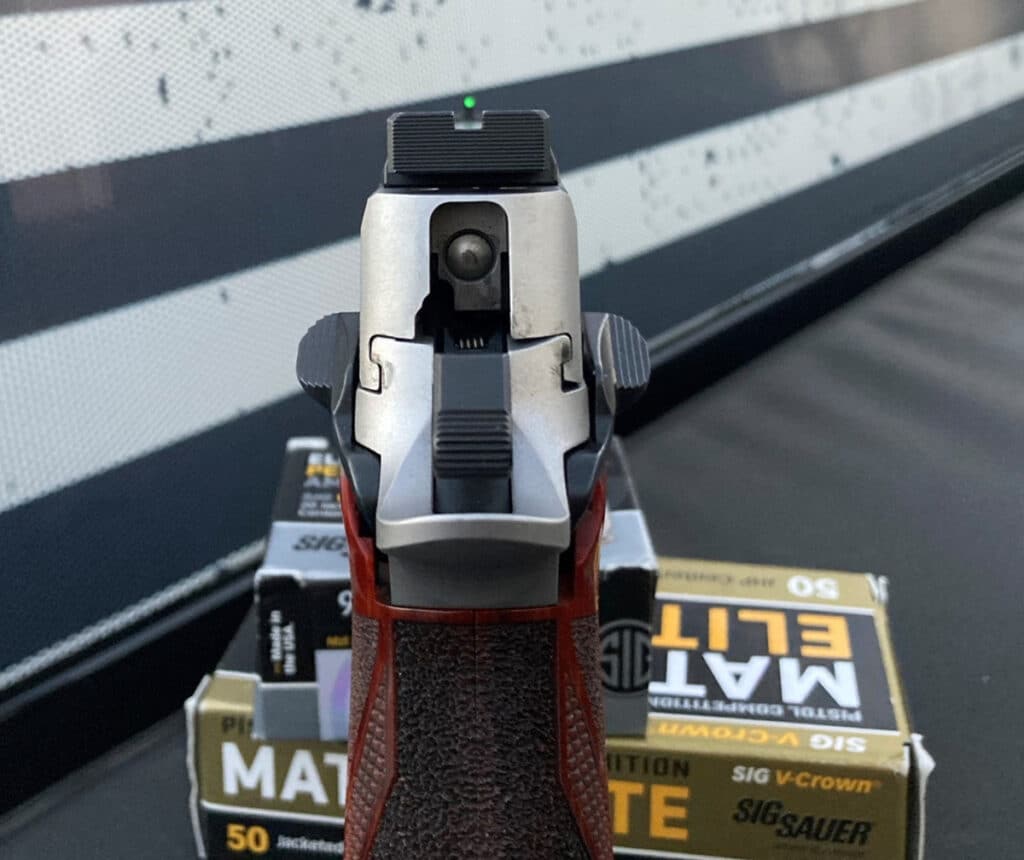
The target sight set up is refreshing to use after years of using handgun sights that feature dots and other designs meant for rapid shot placement at close range. Of late, it seems handgun sights are slowing drifting back to wider rear notches and thin front posts that provide more precise aiming. This trend likely stems from data that shows sights are not used that much in close range affairs; shooters relying on hand-eye coordination for shot placement in defensive encounters. You might as well have sights conducive for longer range work. We found it possible to accurately engage man-sized steel targets at 50 yards; similarly sized targets out to 100 yards had better seek cover with the P226 XFIVE deployed.
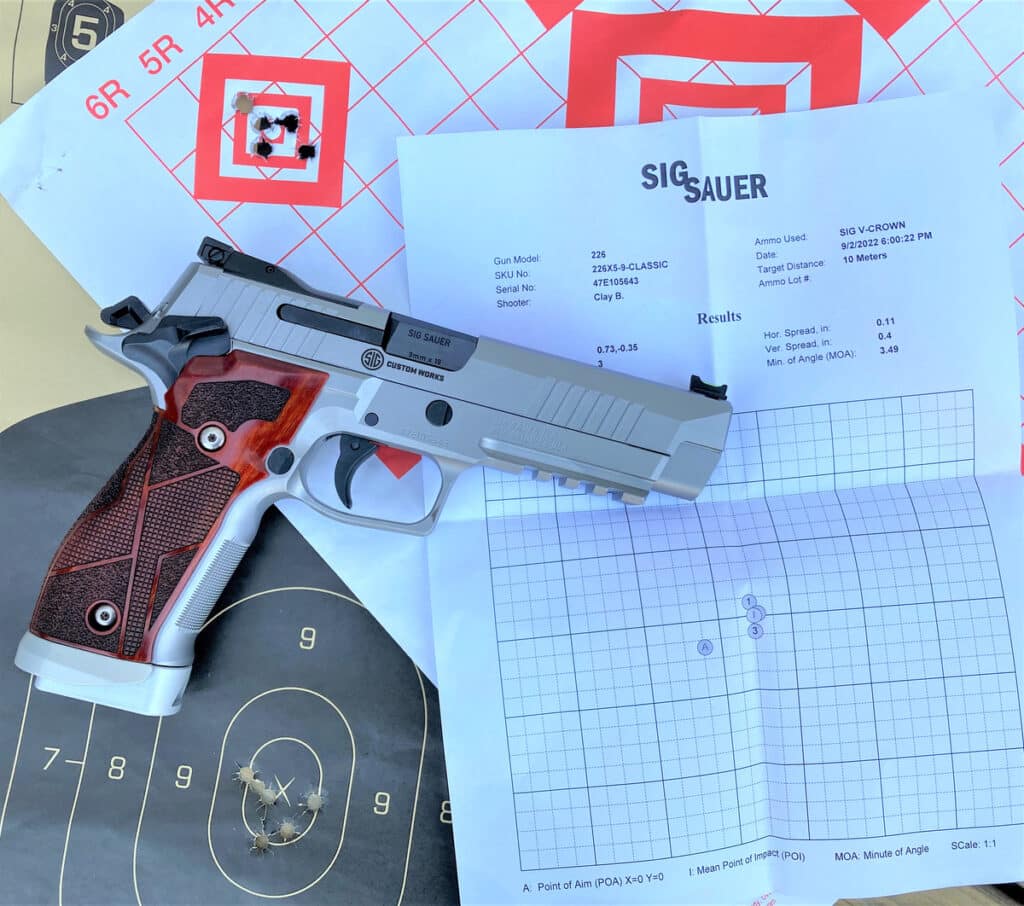
Accuracy
The benefits of the tuned, single-action trigger proved evident during range evaluation. Groups fired were impressive, with bullets unerringly hitting their mark. Rapid fire magazine dumps still found rounds clustered in the “A” zone of an IPSC target. The XFIVE routinely fired groups into one jagged hole at 10 yards. Bench testing could not be resisted after witnessing the unsupported accuracy results. We quickly realized the P226 XFIVE possessed inherent accuracy superior to what most shooters are capable of. That level of mechanical accuracy is a nice feeling that instills confidence in a handgun. Shooting from sandbags produced several 1-inch groups at 25 yards with the XFIVE’s iron sights. It would be interesting to see what size groups the pistol would produce with a red dot optic, especially as distances increased.
PERFORMANCE
| LOAD | VELOCITY AVG. | AVG ACCURACY@25yds |
| Federal 124gr HST | 1139fps | 1in |
| SIG Sauer 147gr Match VCrown | 974fps | 1.25in |
| Hornady 147gr XTP | 981fps | 1.25in |
| Norma 115gr FMJ | 1192fps | 1.5in |
| Federal Syntech 124gr TSJ | 1117fps | 1.33in |
SIG Sauer Elite ammunition led the way in testing with both FMJ, Match and V-Crown JHP loads used. Hornady, Norma, and Federal ammunition was also used. Loads fired spanned 115-grain to 147-grain with hollow points and FMJ bullets. No malfunctions were experienced while test firing over 450 rounds with the SIG P226 XFIVE.
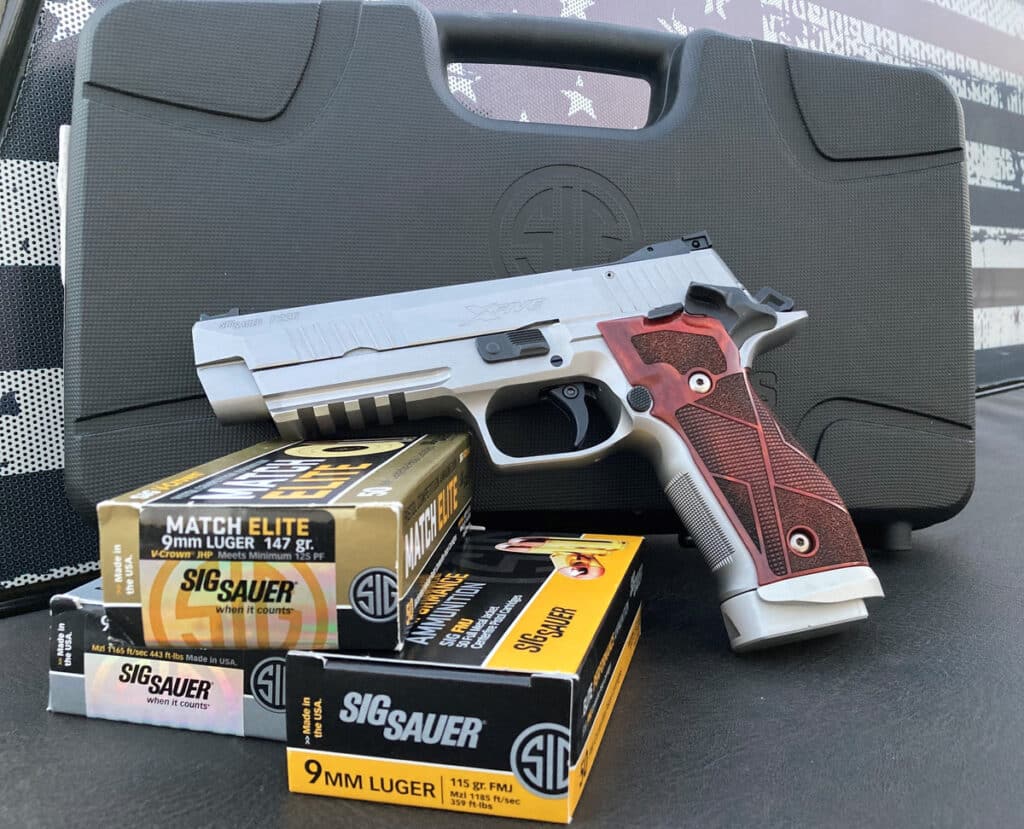
The natural pointability of the P226 XFIVE was confirmed with the speed of getting the sights aligned on target. The manual safety was positive and easy to manipulate. We’ll admit to nostalgic feelings towards the P226 XFIVE’s exposed cocked and locked hammer. The swiping down/deactivating of the safety lever brought back memories of our early days running single action handguns. The beavertail frame settles the weapon naturally into your hand and provides a point of reference when drawing the pistol from a holster. The custom grips tapering up to the slide sits the P226 XFIVE in your hand in such a way that keeps extended beavertail settled over the web of the shooter’s hand.
Wrap Up
Most are unaware that SIG even offers a package like the P226 XFIVE with extended beavertail, single-action trigger, and ability to mount a red dot. All should appreciate what the P226 XFIVE offers in terms of accuracy, reliability, handling, and capacity. The P226 XFIVE’s uncanny accuracy will get everyone’s attention. We should be glad the P226 XFIVE is now U.S.-made for multiple reasons…including increased availability and a more attractive price point.
SPECIFICATIONS
Make: SIG Sauer
Model: P226 XFIVE
Caliber: 9mm Luger
Mags Included: 3-20 round magazines with alloy basepads
Barrel Length: 5in
Overall Length: 8.6in
Sights: Adjustable Dawson-style rear/fiber optic front (Red dot can be mounted)
Sight Radius: 6.8in
Height: 5.9in
Width: 1.7in
Weight Empty: 45.6oz
MSRP: $2399
URL: SIG Sauer



